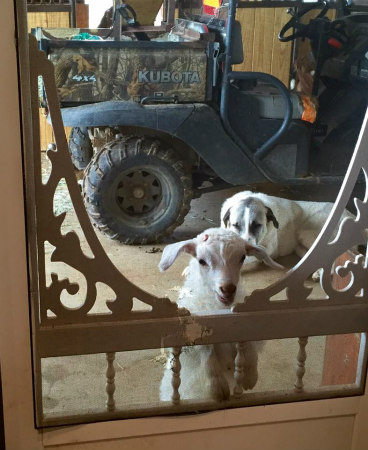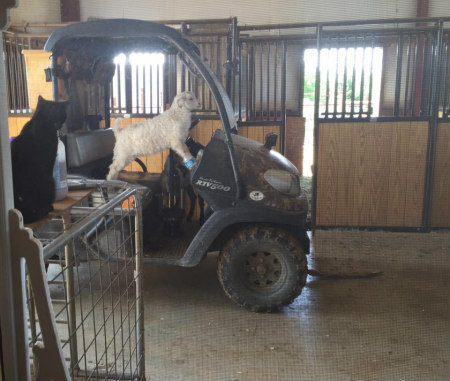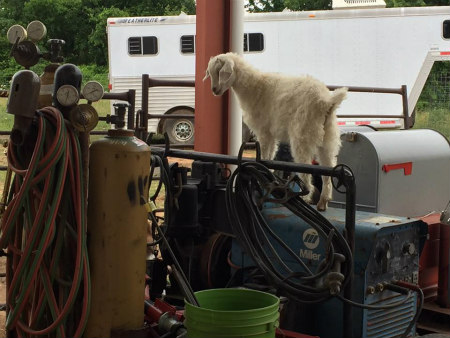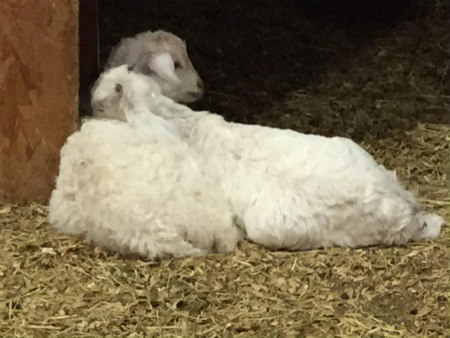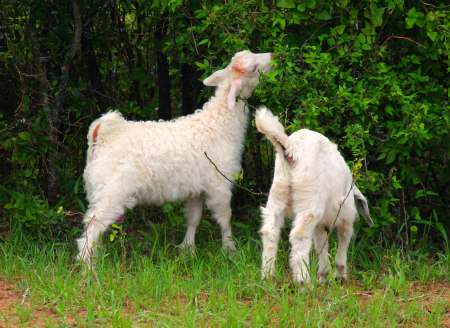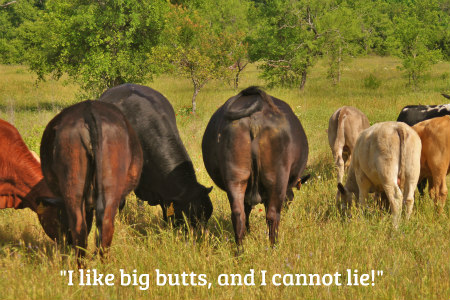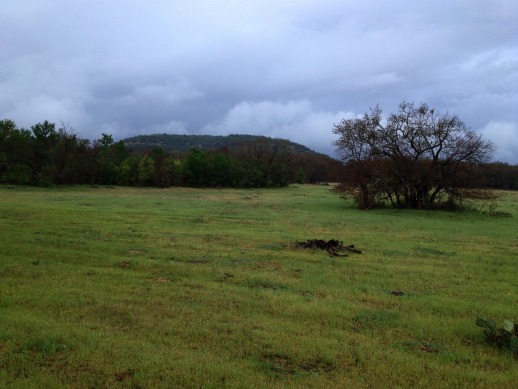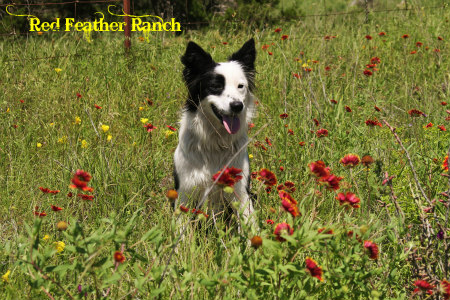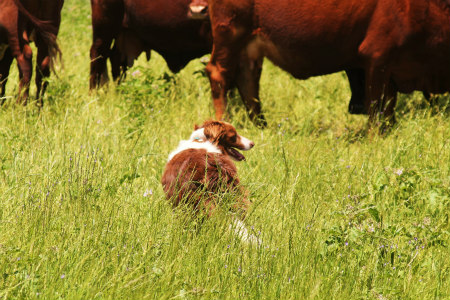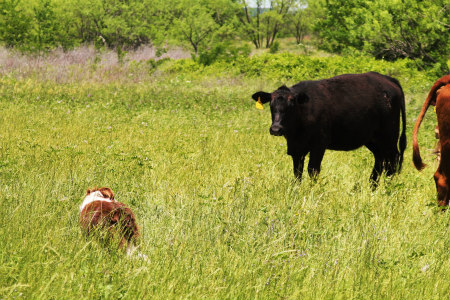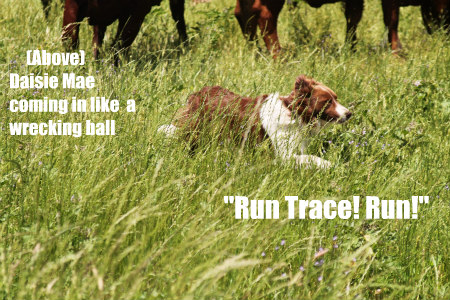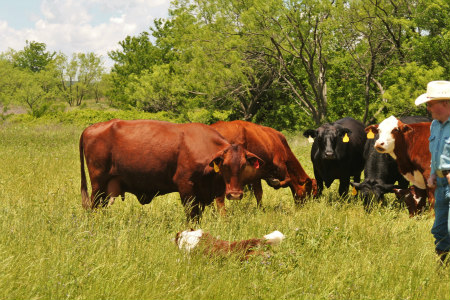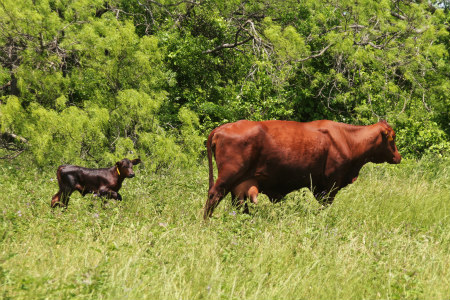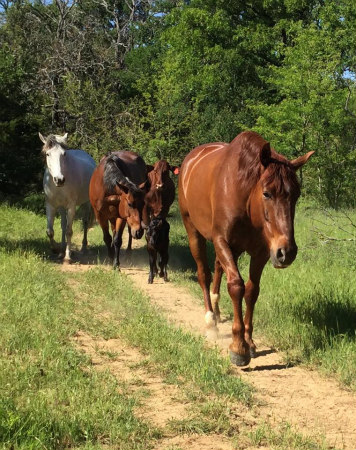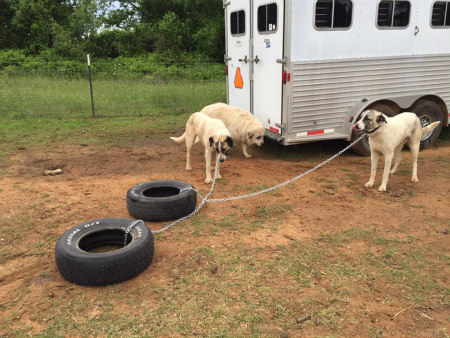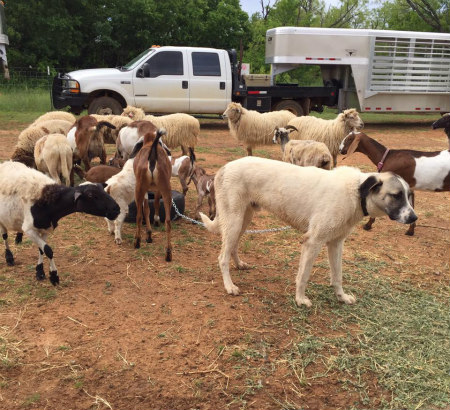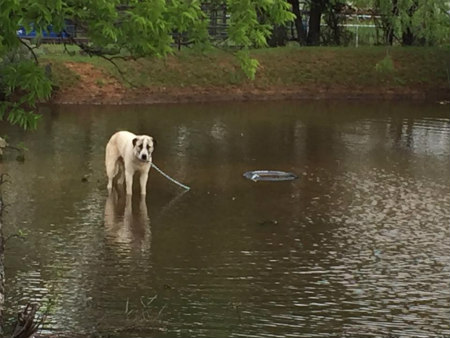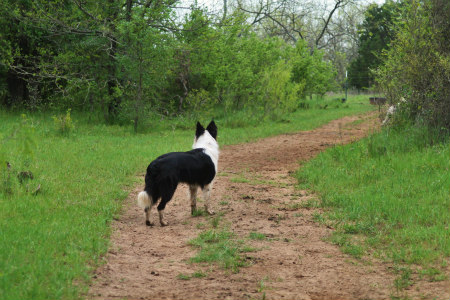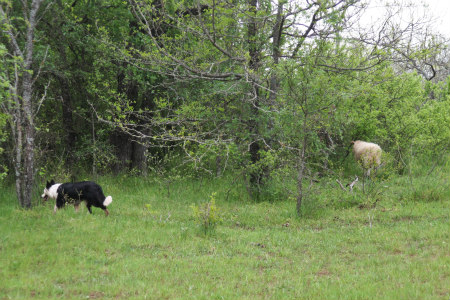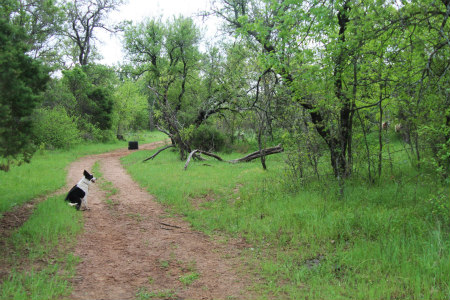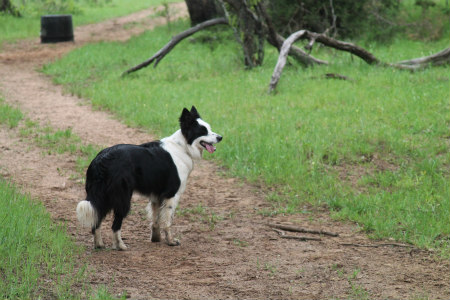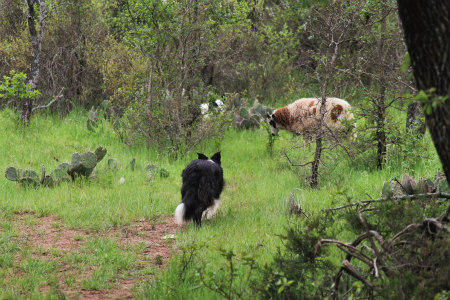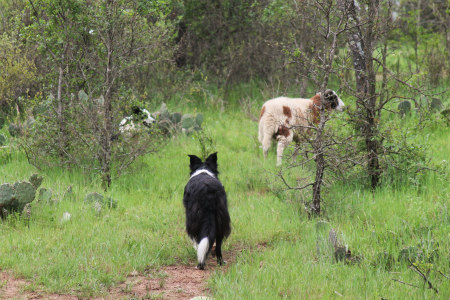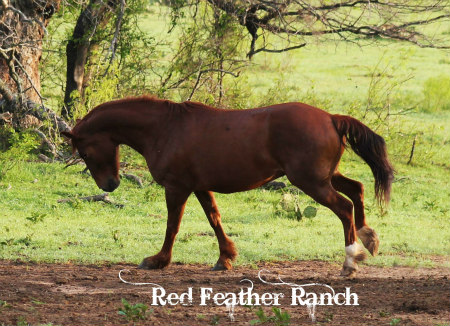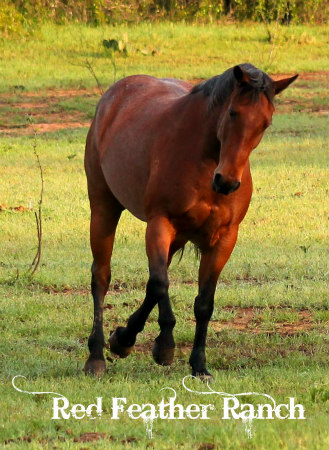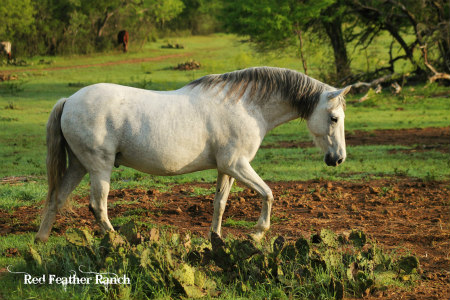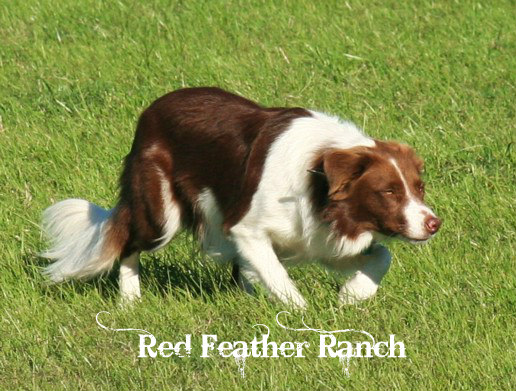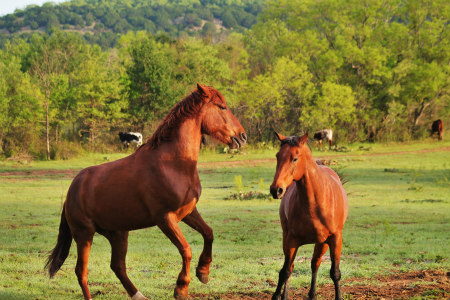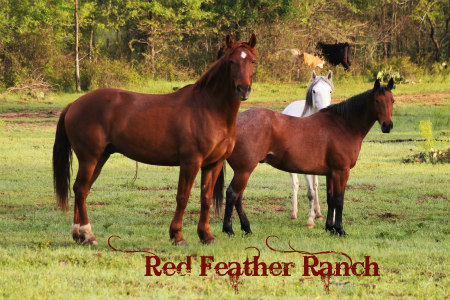Farm Fresh BlogWednesday, June 01 2016
Charles Darwin didn't have to travel to the Galapagos Islands to find enough data for "On the Origin of Species," he could have just spent more time on a ranch to see natural selection at work. The strongest, smartest, fastest, and luckiest survive to reproduce their genes, and make no mistake, luck tends to favor the smartest. Mother Nature is cruel, and the innocent pay for the mistakes of their parents. As humans, we are forever interfering with nature, but doing so brings its own responsibility. If you're gonna play with Mother Nature, be ready to accept the consequences to upsetting natural selection. If you feel so sorry for the barn swallows who built a nest in the tongue of the horse trailer where the cats and dogs could get the babies that you build a safety pen of panels around that area, and refuse to use the horse trailer until the babies fly away, and pen up most of the cats, then be prepared for the fact that you will either continue to breed stupid birds or you'll get your heart broken when a cat gets the birds anyway. And while playing God and rescuing wild animals from their poor choices or the poor choices of their parents doesn't necessarily cost anything more than heartache, the choice of whether or not to interfere with natural selection when it comes to livestock hits you straight in the wallet. It really depends upon the livestock you raise. If you choose to raise dairy goats, kiss any kind of ranching in harmony with natural selection goodbye. These animals are so high maintenance that you must intervene. As farmers we have selected for animals with high milk production, not their ability to survive on their own. Accept it, or don't raise dairy goats.
With sheep and cattle it's a different story. We try to choose breeds with excellent mothering skills, and select individuals within those breeds who are good mothers. The terrain, climate and predator load in some places can enable the mothers, hiding their poor choices. Other places are less forgiving. On our ranch there are very few chances. If the humans are not there to catch the mistake quickly, natural selection swings a hard hammer fast. Calves who stray too far away from the herd can find themselves on the menu at someone else's party. And as poor IB1 apparently found out the hard way, if you choose to give birth right beside the creek, your baby can wobble over the edge and be swept away.
The idea of an innocent calf drowning is heartbreaking. The monetary loss is significant too. And this is where as ranchers, we dance that delicate waltz with Natural Selection. We can choose to harden our hearts, throw the cattle out there, and let the mothers and calves suffer their own poor choices. This insures the strongest, the brightest, and the luckiest survive to reproduce. This can also be very expensive. On Memorial Day $700-$1000 floated downstream. It appears that IB1 had a successful birthing approximately 3-6 feet from the edge of the creek. We found the afterbirth there too. There was no evidence of predators, just the easy roll of the water and the mournful bellows of a cow calling her calf.
On the other hand we could choose to micromanage the livestock and lock them up until the calves are big enough to handle the predators. This is also very expensive because you have to haul a lot of feed to them and they still will not have the bloom that pastured cattle have. And here is where we dance. Because we bred some of the cows to a large-boned Charolais bull and there was the possibility that we would have to assist birthing, we kept those girls penned until their babies were successfully on the ground and very mobile. We hauled gobs of feed to them, and yet still watched the mothers drop weight. The calves got fatter and fatter and the mothers got skinnier and skinnier. It just didn't make sense to continue to haul money in feed when the cattle are surrounded by pastures with tall grass, so as soon those Charolais-bred cows had calves, we turned the entire herd loose. On knee-deep grass the calves got fatter and their mothers started gaining weight again, but every day we drove out there and counted calves. And every day we checked expectant mothers. Because one of those cows was a first timer, this past week we drove out twice a day to check IB1.
There are limits to what we can do though. IB1 had at least 350 acres to have her baby. Most of this was a safe variety of heavily wooded, partially wooded, and open pasture. Instead, she chose to give birth in a heavily wooded area 3-6 feet from the edge of a 15 foot drop-off into rolling water. Seriously?!! What the heck??!!! That's called Natural Selection. I hate it. More than the loss of the money, I hate the thought of that innocent baby drowning. I hate listening to IB1 call for her lost calf. And so we go back to the Natural Selection Waltz. How much do we intervene in their lives? Some decisions are obviously our responsibility. If we choose to breed to a big bull, then it makes sense that we have to help with calving. But after that danger has passed, how much micromanaging do we do? We are running a cow/calf operation in an area that has a very forgiving climate, but unforgiving predators and an unforgiving creek. If the cattle are loose on the ranch, it is physically impossible to micromanage their lives. They have everything they need to survive and thrive here. But they, and we, have to live with their poor choices regarding the predators and the creek. IB1 will breed back in a month or so. If she loses her calf next year then she'll be sold with that calf crop because she needs to be on a ranch that isn't as wild as ours. Maybe she has learned something. I don't know how much cows think about these things. IB1 had an excellent mother herself, so hopefully it was just a novice mistake on her part. From the sound of her calls she clearly didn't just abandon her calf. I feel bad for IB1, but I feel worse for the calf who was an innocent victim of the Natural Selection Waltz.
Monday, May 30 2016
I almost shot him. The only thing that kept me from doing it was the room full of people around us. It started innocently enough a couple of weeks earlier when the pastor asked if I would bring some sheep to a reenactment of Jerusalem Marketplace this summer. Ahhhhhh..... yeah ... sure. (Make mental note to select some candidates and tame them up.) Behold the power of Purina NickerMakers! This little horse treat has tamed more than a few wild sheep, and didn't fail me.
Within a week I had the three Jacob Sheep tamed to the point where they have become annoying beggars.
"You got any NickerMakers???" We had recently sheared these sheep and I've had a blast spinning their wool into yarn. They had surprisingly lovely fleeces. Hopefully by July their wool will have grown out enough to look decent again. At the moment they look kind of naked, but that's okay because they just have to be sheep in a marketplace. Nothing fancy. I'm actually kind of looking forward to it. Flash forward to the Crime Watch meeting. The meeting went well. Other Half had just given a presentation and it was time for new announcements. A lady stood up and reminded everyone of the local Pioneer Days event that was coming up which showcases skills from the 1800s. At this point, my husband, God bless him, stood up, pointed at me, and said, "My wife shears her own sheep and spins the wool into yarn, just like in the 1800s!" Yes, he did. I almost shot him. Oh. My. Gosh. In no time I found myself volunteered to do an all day demonstration of a skill I just learned myself. Okay, yes, I can turn raw wool into yarn, but suddenly being thrust into the spotlight was unnerving. The school teacher inside me slowly warmed to the idea when I realized that I could bring the Jacobs to give people a short course in "sheep to yarn." (Little know fact: Before I went into police work, I taught sixth grade Science for 10 years!)
No sooner had I finally welcomed the idea when my sheep were invited to do another farm event in July, so that's three events in two months. Now might be a good time to train the sheep to walk on leash. I've decided to embrace the idea of doing demonstrations. The key to our future as a society lies in the education of our children, and maybe my sheep can teach children that clothes don't just grow on hangers in The Gap, and maybe, just maybe, I can awaken a spark of interest in the heart of a child. And that spark may ignite to become something bigger. All it takes is one.
Thursday, May 19 2016
Most farms have a few oddities, things that stand out as just not quite like everything else. Last fall Other Half added a couple of Longhorn calves just because he likes seeing them. They definitely stand out as odd in a pasture of beef cattle, but I see his point. I like watching them too. And the red one is very photogenic.
With my goatherd of Nubians, I have these little precious oddities: Natty & Liam
Natty came to us as a foundling who needed a home with other goats. She was like an unplanned pregnancy. We didn't expect her, but now we can't imagine life without this little ray of sunshine.
On the other hand, Liam is not a warm and fuzzy ray of sunshine. Liam is more like a loud blast of happy music that jars you out of your comfort zone but leaves you laughing and tapping your foot as you begin to dance to this slightly different little drummer.
From the first moment I touched Pygora fiber in a yarn store, I wanted to add a Pygora goat to my fiber flock. Liam is that goat. A Pygora goat is, in essence, a cross containing a specific percentage of both Angora and Pygmy goats. It is its own breed now. I've had a lot of goats, but Liam is definitely marching to a different drummer. He combines the clownlike personality of a Pygmy goat with the charming annoyance of a bottle baby imprinted on humans. Natty was a bottle baby, but she wasn't imprinted on humans. Natty knows she's a goat. Liam doesn't. Liam is not a goat. Liam is a Liam. He's loud. He's demanding. He's naughty. And yet he's the most adorable little rascal to ever attempt a dictatorship.
Liam climbs on the mule, and pees in the seat.
He climbs on the welding machine.
He climbs on the tool table. If you leave the tailgate down, he will be in the bed of the pickup truck, and from there, it's just a skip and a hop to the top of the truck. Yes, I've found little hoofprints in the dust up there. Liam gets into trouble the other goats never considered. He climbs things for the challenge of reaching new heights. He flings himself with wild abandon in his quest to reach new heights. One morning I watched him repeatedly run up the front of the mule, across the hood, and up the windshield before falling back to the ground. Over and over and over again. He was like a teenager at a skateboard park. And like the mother of a teenaged boy, I am constantly worried about him ending up in the ER. Liam gave us quite a scare one night when he appeared to have knocked himself out from leaping into the corral bars. We didn't see him do it, I just found him lying in his pen. He was groggy and very un-Liam-like. We whisked him into the house for observation while I considered whether or not I should take him to the ER. Fortunately he was just dazed and given a little time he was back to being Evel Knievel again. Natty is his constant companion.
They fit together like Peanut Butter & Jelly. As if from the Island of Misfit Toys, these two have found each other and are best friends. Natty is no longer exhiled while the other babies snuggle in one giant Nubian pile. Now she and Liam form their own snuggle pile.
Natty is Liam's liason to the other goats. The Nubians don't really understand Liam. Natty may not understand his special brand of genius either, but she likes him and makes a point of keeping up with him.
They are George and Gracie. (If you're under 50, Google it.) Natty is the Leonard to Liam's Sheldon. (If you're over 50, Google it.) Whatever else they are, Liam and Natty are family. Tuesday, May 17 2016
You know you live in a ranching community when you go to church and someone says, "The water tanks are full, the grass is green, and the cattle are fat. Thank you, Lord."
This has been an unusually wet year. Our ponds are overflowing and the cattle are standing in grass up to their bellies. Anyone with livestock will tell you that few things make you feel more secure than the sight of a barn full of hay and pastures full of grass. Paper money is an abstract form of wealth, and depending upon world events sometimes it's no better than Monopoly money.
This kind of wealth is also not so complicated that we forget where it really comes from. Farmers and ranchers are tied to the land, and more often than not, they are quick to give thanks to God. I once read somewhere that the more intelligent someone was, the less likely he was to believe in God. The implication of the article was that only simple people believed in a higher power. Anyone who was smart enough to question things knew better than to buy the whole God-package. I would imagine that the person who wrote the article would also argue that intelligent people were smart enough to find air-conditioned desk jobs too. And ironically, he would probably make this argument over a steak dinner. My experience has been that people with full bellies and full bank accounts tend to be a bit more liberal in their beliefs when hard work isn't involved. Success can foster arrogance, and it seems that the further we get away from our dependence upon the land, the more we get out of step with God. Maybe it's as simple as the office. Perhaps if you live and work in a place like this it's easier to say, "Look what man has created. There is no God."
On the other hand, this could be your office, and each morning you could arise and say, "Look what God has created."
It really may be as simple as office space. If you are surrounded by the accomplishments of man, you have to search a little harder for God amidst the chaos, for God does not shout, He whispers. In some places, it's just easier to hear Him.
Tuesday, May 10 2016
Retired K9 Officer Aja lost her battle with cancer today. We shall always be thankful that Aja was a part of our lives. As befitting an officer, Aja was wrapped in a flag and buried under the pecan tree in the pasture that faces the mountain. Her happy, goofy face will now brighten Heaven. Here's a salute to K9 Officer Aja.
Tuesday, May 10 2016
We tap dance with the predators around here. Just before dusk each night the coyotes gather up and sing. Although four coyotes can sound like forty, I'm still pretty sure we have a double digit coyote pack around here. It's tempting to actively hunt them but to do so would simply open the niche for a less stable pack to move in, so we opt to manage our livestock instead. We have Livestock Guardian Dogs for the sheep and goats, and if they are grazing in pastures away from the barnyard, we escort them with Border Collies and return them home when their bellies are full. Micromanaging the small livestock is easier than cattle. One would think the cows can take care of themselves, but baby calves are vulnerable. For this reason, we kept the first time mothers close to the house until their babies were big enough to discourage an attack. We do have tiny babies now, but their mothers are veterans who will kill a dog in an instant, so we assume coyotes would fare the same. It's hard to keep weight on nursing mothers that are penned, so last week we turned them loose. Naturally we had a baby born in the forest, but she was born to Daisie Mae, a battle ax of a cow who thinks nothing of tossing dogs or humans. (Homegirl needs to head to the auction barn as soon as her baby is weaned.) We still check these cows daily to make sure all the calves are still alive and take note of any cows getting ready to have babies. Trace comes with us because, like a Trunk Monkey, you never know when you'll need a Border Collie. I'm sure there are better trained and fancier working cow dogs out there, but Trace does a fine job and doesn't have the bravado that would get him killed, so he's #1 CowDog when working pairs. This is because Trace has enough sense not to take the fight to the cows. With cow/calf pairs that attitude can get you killed. Lily has a no-nonsense approach that is best used in other situations. Trace's stare/retreat/regroup/"I'm still here" approach tends to work better with pairs. He gets the job done without upsetting cows or getting killed. Sometimes retreat is the better part of valor, or as Shakespeare's Falstaff says when he defends a seemingly cowardly act of playing dead to stay alive, "The better part of valor is discretion, in the which better part I have sav'd my life." In other words, doing what you have to do to live another day is a part of valor. Trace lives by that code. Here he is with Daisie Mae, the Battle-Axe-Bitch-Cow. Trace walks out with Other Half.
The cows notice him in the tall grass and decide he is a predator that must be stomped.
Retreat. Regroup. Reconsider.
Daisie Mae decides that it's easier to just take her calf and move. It isn't showy, but the cow moves and everyone is still alive. Although Lily would call this cowardice, she has been kicked and run over many more times than Trace, so when you hang your hat up at the end of the day, if the job got done and nobody ended up at the vet or in the ground, I guess it's all good.
Monday, May 02 2016
A dear friend of mine once described me as being afflicted with "catastrophic expectations," where your mind races towards the worst possible conclusion to even the slightest bump in the road. She recognized the disease because she suffers from it too. If someone is more than a few minutes late, we immediately assume they're dead in a ditch somewhere and begin making funeral plans in our heads. As you can imagine, a career as a crime scene investigator did nothing to dull my sense of catastrophic expectations, and neither does living on a farm. It works like this: If you have a favorite goat, that's the one who will die. If a particularly beautiful baby goat or lamb is born, that's the one who will die. If a calf is missing, the coyotes got it. That lump in the yard is a dead chicken. The bushes the Labrador just stuck his head inside will contain a copperhead. It happens often enough that things like that are always in the back of your mind. If you have enough animals, someone is always in crisis, on the verge of crisis, or recovering from a crisis. Sometimes just right out of the blue, tragedy hits you. If you have sheep and goats, you are always worried about worms, coccidiosis, accidents, and predators. I just got coccidiosis cleared up in a wether who wouldn't maintain weight. He's starting to bloom. Now I have to worry about occasional diarrhea in one or both of the bottle baby goats. Is it the formula? Is it the spring grass? Is it the fact that they are now eating alfalfa and pelleted food too? They aren't sick, just runny every few days, so we just keep playing with variables. Aja, the retired patrol dog, appears to have Inflamed Bowel Syndrome, which is in essence, a wasting away disease where her bowel is rejecting food. This is apparently common in some lines of German Shepherds. It can be somewhat controlled with the use of anitibiotics and steroids, but the longterm use of drugs brings its own problems, and they don't always work. Thus we find ourselves juggling her diet. Commercial dog food just doesn't cut it now. She does best on raw food, including raw meat, cooked meat, and cooked eggs. She looks like a prisoner of war now, but she is happy and so we continue to juggle her diet to find things her stomach will tolerate. I worry about her and don't see a bright future in the horizon, but we take it day by day. If she's eating, I'm happy. If she doesn't, my mind immediately jumps to catastrophic expectations. This week we had a new calf born to our nasty tempered escape artist cow. This old bitch will kick a dog or toss a human in an instant. I've wanted to get rid of her for the last two years. Other Half has a lot more patience because she is a valuable cow who produces nice calves. She has always produced bull calves. I finally got Other Half to agree to sell her as a pair as soon as she calved this year. Someone else can deal with a cow that tries to kill stockdogs and leads the entire herd off the property. Naturally Nasty Cow produced a heifer calf this year. Since we probably want to keep that calf, it means we still have to keep the nasty cow until her calf is weaned. When I first saw the calf, much to her mother's distress, she had fixated on Tiny and was trying to keep up with his little band of horses instead of her mother.
I guess one red butt looks just like another one. The horses tolerated this pretty well. Eventually her mother reclaimed her. The next morning the calf was missing. A veteran of "catastrophic expectations" I immediately assumed the calf had been killed by coyotes, or bogged down in the creek during one of her mother's escape attempts, and then killed by coyotes. We did eventually find the calf, but I won't stop worrying about her until she is large enough to fend off predators on her own. This kind of calf is definitely fodder for catastrophic expectations. The Livestock Guardian Dog puppies are ten months old now and are right at the age where they want to escape their responsibilities and run the forest chasing hogs and deer. This is a dangerous sport. The hogs have little piglets. This week The Boyz disappeared for almost two hours. I was worried sick because I had just seen a herd of pigs near the fence where the goats were grazing. I drove off in search on a 4-Wheeler and ran smack into hogs with piglets. We parted company quickly, but being a veteran of catastrophic expectations, I was then certain both boys were bleeding or dead after a hog attack. Two hours later I found the little bastards playing in a watery bog beside our pasture like drunken frat boys. The entire time I had been worried sick, they had been having a party. I was not amused.
All livestock guardian dogs roam, it's in their DNA. It's why so many end up in rescue. You have to train them through that stage. Some never get out of the stage and you just have to adapt their environment so they can't escape. When Briar was this age she was horrible about climbing fences. Since she didn't leave the property, I really didn't worry about it until the day we saw her climb the fence like a giant white ape to attack the garbage man who fended her off with a trash can. Time for hot wire. Briar eventually outgrew the stage and now she is a reliable guardian dog. And the Anatolians will be too, but they still have to be monitored through this stage. Thus it's time for tires.
We fitted them with wide Bite Dog collars and chained them to tires that they drag around the yard. It doesn't keep them from moving but it sure does elimate that digging under the fence and have frat parties in the forest. If you don't immediately see them, follow the drag trail of the tire.
Naturally this also feeds my catastrophic expectations because even though we've taken precautions, I still obsess about dogs hanging themselves, thus if the boys can't be loosely monitored, we still will lock them behind bars. It's just not worth giving myself an ulcer.
If you live on a ranch, you get used to tragedy laced amid the beauty like a rattlesnake hiding in a field of wildflowers. It's just there. You can choose to focus only on the wildflowers, you can choose to focus only on the rattlesnake, or you can wear snake boots and keep on going about your day. I wear snake boots. I don't deny the snake exists, I expect it, plan for it, and work around it. Some folks call that "catastrophic expectations." I call it planning for reality. If bad things happen, you're prepared. If they don't, you're pleasantly surprised. Friday, April 29 2016
I felt the stirring so many years ago when I tended goats browsing scrub brush the first time. It is an awakening inside the soul that reaches as far back as biblical times, people tending goats and sheep as they graze. It is a quiet time, filled only with the sounds of birds, crickets, the snatching of limbs, and the patient grinding of teeth. It is a time of reflection. It's a time to get right with God. The Bible doesn't mention it, but King David would have had an easier time of things if he'd had a Border Collie when he was tending the flocks. They sure make my life easier. We have a central barnyard where the sheep and goats are loose most of the time, but we also have three leased pastures and our own larger pasture where we can graze animals. The hitch is that with the exception of the barnyard, none of these other pastures is fenced for sheep. All the pastures are wild. Think hundreds and hundreds of surrounding acres filled with heavy brush thick with predators, creepy crawlies, and the occasional steep drop-off into the creek. These acres also contain horses and cows who don't always mix well with small animals. One cannot simply open the gate and turn sheep loose around here. They may or may not come home, and the zombies will eat anyone outside the barnyard after dark. But that's where all the grass is! Grass up to your knees! Browse so thick that only goats want to be in there! The only answer is to use the dogs. After all, that's what I pay them for. And they pay for themselves.
Mesa turned a year old this winter and she is already invaluable around the ranch. I haven't put a lot of training into her yet, I just use her around the farm, and she is ever so handy. She is quick to figure out what the goal is and make it happen. It's easy to micromanage a dog around the barnyard, but in deep brush, you just have to sit back and let them work. I can't see them most of the time. The rules of the game are simple: Keep the sheep between the deep forest and the perimeter fence. When asked to gather them up, roll the sheep and goats into a ball, and roll your ball back to the barnyard. This is peaceful, easy work unless the horses show up. When that happens the humans must snatch up bottle babies, who don't flock well with the herd, while the dogs gather everyone else up quickly and push them through the gate before galloping horses can trample young goats. The dogs and the herd are getting pretty good at these fire drills. I am most impressed with Mesa. She has excellent distance. She gathers better than Lily, and drives better than Trace. Although we use all three dogs, Mesa seems to do the bulk of the work. Lily stays close to me as I sit on a bucket, and Trace sits on a 4-Wheeler with Other Half. Lily and Trace don't work much unless there is a problem. Mesa takes care of pretty much everything else. I don't have to watch the sheep thick in the brush. I just watch Mesa. She watches the sheep. I'm fascinated by her commitment to task. She waits until a sheep strays too far,
and then she dispatches herself waaaaay around the animal,
pops up in the forest in front of them, and points them back to the flock. I don't tell her a thing. She has assigned herself this job.
This is the product of countless generations of breeding working dogs. It's not about registration papers. It's not about looks. It's about whether or not the dog can really do the job. I have great appreciation for the saying, "The bullshit stops when the tailgate drops." And it does. The proof is in the pudding. Does the dog really work? I watch this tiny little dog thread her way into the forest to return a sheep to the flock without any direction from me and I am thankful to the generations of ranchers who bred these dogs for a job.
I cannot do what I do without the Border Collies. Calling sheep with a bucket of grain isn't gonna cut it when they're standing in grass up to their elbows. The brush is too thick to tend them on horseback. You simply must use the Border Collies. And that is what they live for. These photos are a perfect illustration of tending the flock. This Jacob wether has strayed past the invisible "no fly" barrier and the dogs have dispatched themselves. Mesa has popped up in the forest in front of him as Lily stalks in like a hired gun.
No rush. No barking. No teeth. Just a promise. The wether has to make a decision.
He chose wisely.
This scene plays out over and over again without drama. The dogs allow us to graze the small livestock in the wilder areas. We can utilize terrain otherwise cut off to us. It isn't field-fenced, and so you still have to sit out there with them. I sit on a bucket and admire the scenery. Other Half sits with Trace and plays on Facebook. He can do that because the dogs work for him. And THAT is why we have Border Collies.
Monday, April 25 2016
Yesterday I posted some pictures on my personal Facebook page with a footer that confused some folks who also read my website farm blog.
An old friend of mine in another state asked what was the deal between Failte Gate Farm and Red Feather Ranch. Well, that's a good question. It's been causing a problem for some time now so I guess it's a good time to straighten it out. Before Other Half and I got married, I raised goats at Failte Gate Farm and he raised cattle at the Rocking RL Cattle Company. Then we got married. Because of different locations, different accounts, and tax issues, we kept the farm names and paperwork separate. Then we sold my farm to buy the big ranch we live on now. We named this location Red Feather Ranch. We couldn't find any other name we agreed upon and since Other Half calls Trace, "Red Feather", we named the ranch after his nasty little Border Collie.
We still ended up keeping things separate because by that time I already had a Goat Milk Soap business under the name "Failte Gate Farm." I had the business cards, the banner, the works. The Dairy Goat Association has the name registered for me. But now we're up here full time. We officially live at the Red Feather Ranch. All cattle and horse operations are under the Red Feather Ranch. I end up fielding a lot of questions about the two names. No one in Texas can pronounce "Failte" (fawl cha or fawl sha) or knows that it is Gaelic for "welcome." This has led me to go ahead and make the switch. I will slowly begin the transition from Failte Gate Farm to Red Feather Ranch. I'm still not sure what I'm gonna do with the Dairy Goat Association since the Red Feather name was already taken by someone in California who is apparently no longer registering goats with that association but bought lifetime rights to the name. I also have to figure out what I'm gonna do with Facebook since there is a Red Feather Ranch Facebook page and a Failte Gate Farm page. I manage both. At the moment, the Red Feather Ranch Facebook page is more geared to Other Half's cattle stuff. We'll have to see how I sort that out. Bear with me! It might get a little wild for a while,
but we'll get it all settled down soon.
Thursday, April 21 2016
The steady rhythmic squeak of the treadles is soothing as the soft fiber slipping through my hands twists itself into yarn at my fingertips. The wheel needs oil but I can't shake myself away long enough. This process of taking animal hair and turning it into yarn has me mesmorized. Still waddling like a baby along my journey into spinning, weaving and knitting, I discover that like tending sheep and goats, this tugs at pastoral roots deep in my soul. I am a child again, playing Jacob's Ladder with string in my hands. As my fingers slide through the white fiber I wonder about the animal that gave this season's wool. And the farmer. A tiny piece of vegetable matter flicks past my fingertips. Did the farmer, like me, feel that twinge of annoyance each time they saw a sheep dribbling alfalfa onto her neighbor's back as she placidly chewed hay? Did they run their fingers along the backs, parting the fibers to check the wool? How did they shear their sheep? Did they do it themselves or did they hire it out. Did this wool come from a farmer with 50 sheep or a place with 500 sheep? Wool is sunshine metabolized and I can feel the warm rays of the sun as it slides through my fingers, is pulled into the wheel and is twisted into yarn onto the bobbin. I still get a thrill. Fresh into my journey, I don't want to forget these images or have them lost, jumbled behind more mundane thoughts when the mind wanders as the fingers spin. The most important lesson I have learned thus far is that there is no right or wrong to spinning. That knowledge is tremendously freeing. There are as many different ways to spin as there are spinners, and the proof is on the bobbin. Are you producing a yarn you are happy with? If so, keep on doing what you were doing. I am learning as I go. Once I have produced a single ply yarn, I learn that I must produce another yarn and ply them together in the opposite direction so the final product is stronger and more balanced. Alrightie then. Away we go. There is a simple joy to learning as you go. Perhaps if one knew all the work ahead, the step by steps may seem so daunting that one would be afraid to take that first step. But if like a baby, we wobble around in unbalanced wonder, we get to enjoy the process. And we get a true understanding as to why handcrafted items cost so much. Once the yarn is plied, another trip to Youtube reveals the next step in the process. We must now wash it and hang it dry. It is shameful the amount of pride this brings to a woman of my age. It is like successful potty training. You want to show everyone but the world is not as impressed as you are. Ah well, more's the pity. My dear friend and mentor, my Spider Woman Sheep Mother, has told me that part of your soul gets spun into the yarn. I understand this now as I begin to knit with the yarn I spun. I don't know how to knit. Seriously. Just like spinning, I'm learning as I go. I lean heavily on Youtube and tips from friends. I had absolutely no interest in knitting before I discovered the allure of wool. Knitting and crocheting were things grandmothers did. Why knit socks when I could buy them? That was before I discovered the emotions that run through you like a warm current of sunshine as you run fingers across soft fiber. Your fingers read the wool like braille, telling you the story of the sheep, the rancher, the spinner, and finally the knitter. You feel them all, a piece of each, twisted together with sunshine and a prayer. Unlike my attempts at knitting with commercial yarn, this yarn recognizes me. My fingers recognize the yarn. It is very forgiving of my novice attempts at knitting, and we learn together. What does it want to become? Is it a scarf? Is it a cowl? A headband? The yarn is alive, and I'm knitting a life.
I watch my sheep graze in the pasture and my fingers itch to knit their wool. My churro are coarse haired sheep and already I'm thinking of carpet boots for next winter. Do I have a clue how to make carpeted boots for myself? Nope. Not a clue. But I have sheep. I have a spining wheel. I have Youtube. And I have a dream of sunshine, grass, sheep and yarn.
|








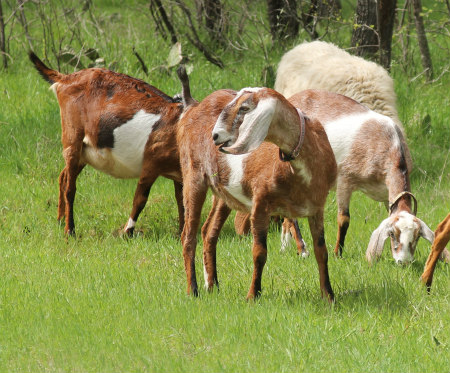
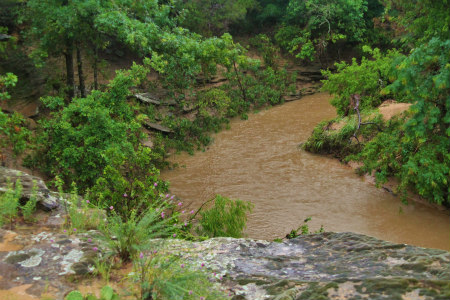
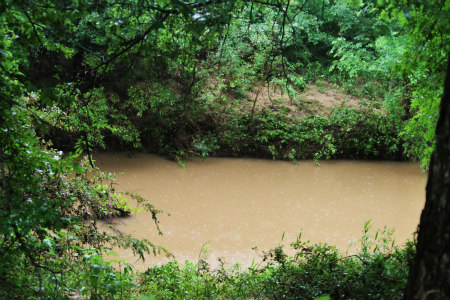

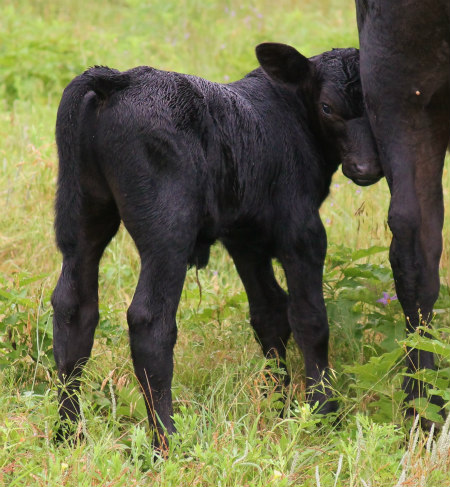
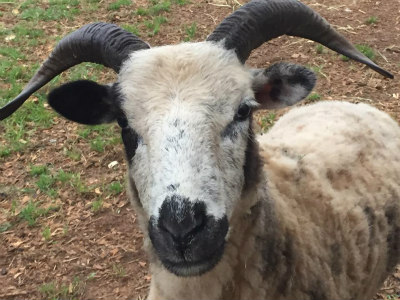

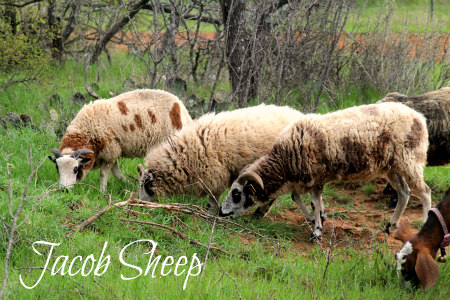
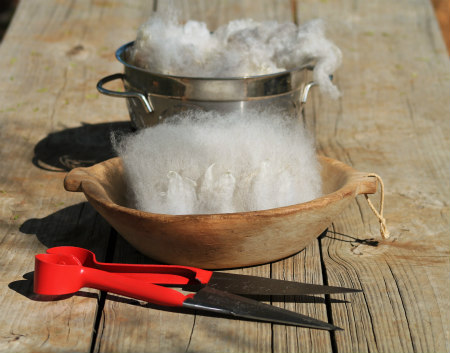
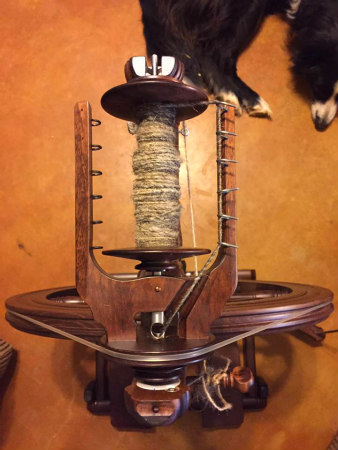
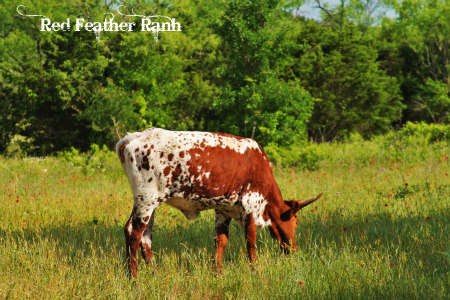
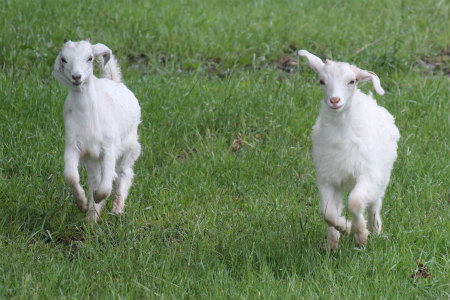
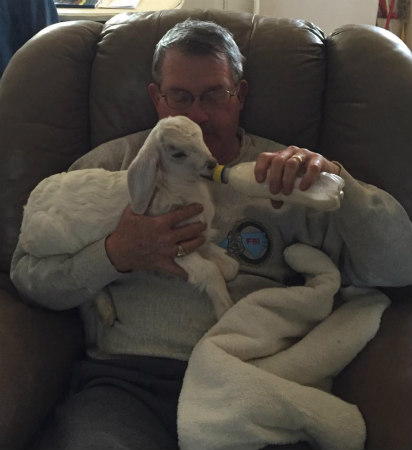
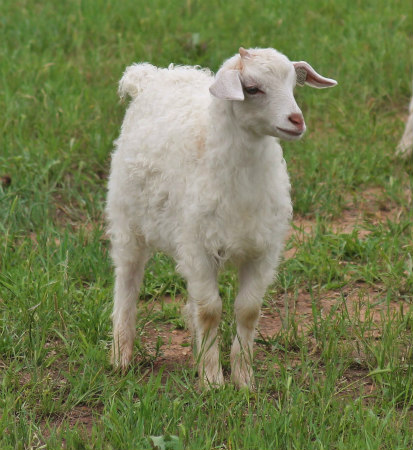 Yes, he really is as soft as he looks.
Yes, he really is as soft as he looks.